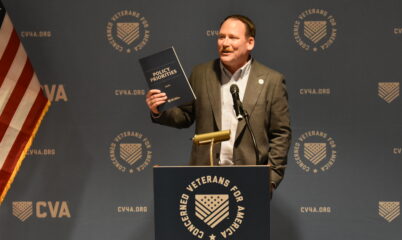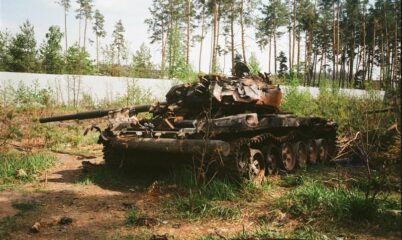
What would happen if the U.S. had to combat Russia? We answer that question and more
Since the Russian invasion of Ukraine began in late February, there has been no shortage of ideas and proposals put forward for how the United States should respond. Unfortunately, while many of these ideas are well-intentioned, too often their potential secondary and/or indirect consequences are not fully explored.
Given the chaotic nature of war, when we think about proposed courses of action, it is imperative that we ask some important “what if” questions to examine what might happen, and not just what we want to happen.
What if the United States and NATO imposed a no-fly zone over Ukraine?
We’ve seen continued widespread calls to implement a no-fly zone over Ukraine. For several weeks the call to “close the sky” over Ukraine was repeated in every corner of the press and social media. However, it was clear that many people advocating this idea did not stop to think about what such a plan actually involved.
A no-fly zone doesn’t mean aircraft wouldn’t have the ability to fly over Ukraine. Rather, it just declares consequences if aircraft do fly over Ukraine. This edict would require enforcement – meaning American aircraft and pilots flying into harm’s way – and could realistically end in death and the war escalating to a wider conflict.
While the Russian military has not had a stellar performance in the war so far, it would be a grave mistake to simply assume the Air Force would zoom in and neutralize Russian forces without issue. Planes would inevitably be shot down and pilots inevitably killed.
Enforcing the no-fly-zone would mean Russian and American fighter jets would directly clash, all-but-guaranteeing wider war.
What if the U.S. continues to increase aid and weapons transfers to Ukraine?
The White House and Congress have been greenlighting billions of dollars in aid and weapons for Ukraine in its fight against Russia, most recently by fast-tracking $40 billion in aid.
The package’s intentions, to assist a country in defending its freedom, are noble. Nevertheless, the ramifications for those actions put the U.S. at increasing risk.
First, the U.S. is already over $30 trillion in debt with ever-rising inflation. Continuing to pour money into another country’s defense will drive our debt even higher and put our economy at further risk at a time when we can’t afford it.
Second, weapons transfers are damaging our readiness at home. So far, supplying Ukraine has depleted a full third of the entire U.S. stockpile of anti-tank Javelin missiles in about two months of fighting, not to mention numerous other military supplies. The more we send, the less we have for our own defense.
Third, if the U.S. continues to send money and weapons to Ukraine, Russia has more opportunity to claim the U.S. is acting aggressively and use those transfers as a reason to attack the U.S. or other NATO members. With the tension already high between the U.S. and Russia, our leaders don’t need to give Russia an excuse to strike, particularly given our economic challenges.
What if Russia attacks a NATO country?
What would happen if Russia retaliated against or preemptively attacked bases in NATO countries? Even if American forces were somehow not attacked, the member state struck would swiftly invoke Article 5 of the NATO Charter, which considers an attack on one member as an attack on all.
Technically Congress would have to declare war if Article 5 was invoked, but, whether Congress voted on it or not, the U.S. and its tens of thousands of troops in Europe would almost inevitably become embroiled in a war with Russia if the article was invoked.
This war would be truly uncharted waters in multiple ways.
The U.S. hasn’t had to directly fight a great power since the end of WWII. Combat with Iraq, Libya, or Afghanistan isn’t comparable in any sense to what combat with Russia would be like.
For two decades the U.S. military has been engaged in guerrilla warfare with opponents that lack heavy artillery, armored units, or air capabilities. The Russian military would be engaging in combined arms operations and utilizing massed rocket and tube artillery fire that the U.S. military has little first-hand experience with in recent decades.
We should not mistake Russia’s poor performance in Ukraine for its inability to quickly impose serious casualties on U.S. forces. Our troops would be fighting without reliable air superiority and experience vulnerabilities they haven’t faced in generations. The casualty figures already coming out of Ukraine suggest that U.S. casualties would dwarf those America has experienced during its 20 years in Iraq and Afghanistan, even if we were winning on the ground.
The entire makeup of the U.S. military would likely have to change too. Current forces are all volunteer and have been since the 1970s, but a full-scale war in Europe would likely require many more troops. Reinstituting the draft could prove necessary, and that could include drafting men and women to fill the ranks.
And while the wars in Afghanistan and Middle East have left daily life largely uninterrupted here at home, a war with Russia would be a different story. Large wars eat up vast amounts of resources, and every tank, shell, and missile that is manufactured is created at the expense of some other want or need in the economy that would now go unfulfilled.
A full-on war would require major disruptions in the economy, which is already reeling under inflation and supply chain pressures.
The U.S. would also have to shift its focus and resources away from the rising threat of China, which would put American strategy in the Pacific in a precarious position.
What if conflict becomes nuclear?
Perhaps the most important question is what would happen if war with Russia escalated to the nuclear level?
The risk of nuclear escalation is very real, especially if Russia felt backed into a corner. The Russian Federation has almost 5,000 nuclear weapons and if Vladimir Putin and other Russian elites felt that its very existence as a unified country was under threat and that they had nothing to lose, we could expect them to resort to nuclear weapons rather than be defeated.
Russia could likely begin escalation by dropping a tactical or low-yield nuclear weapon onto a Ukrainian city or military formation as a warning to the United States to keep out. Unless cooler heads prevailed, an American response could ultimately lead to a general global nuclear exchange that kills tens of millions and leaves millions more at risk of starvation as global trade, at least temporarily, collapsed. Even if nuclear war was avoided, breaking the nuclear taboo in combat for the first time since 1945 would be a devastating precedent for human history.
These risks and considerations are the reality of escalating conflict with Russia. While the world is shocked and appalled by Russia’s immoral attacks on Ukraine, U.S. leadership has a responsibility to protect the interests of its own people first and foremost.
With these “what ifs” in mind, what are you willing to see happen? Are you willing to see U.S. men and women die overseas? Are you willing to see your family and friends drafted? Are you willing to go without at home to support a war in Europe? Are you willing to accept the risks and consequences?
Want to know more about the Russian war on Ukraine and what the U.S. response should be? Check out this Q&A with Senior Policy Analyst Tyler Koteskey.




